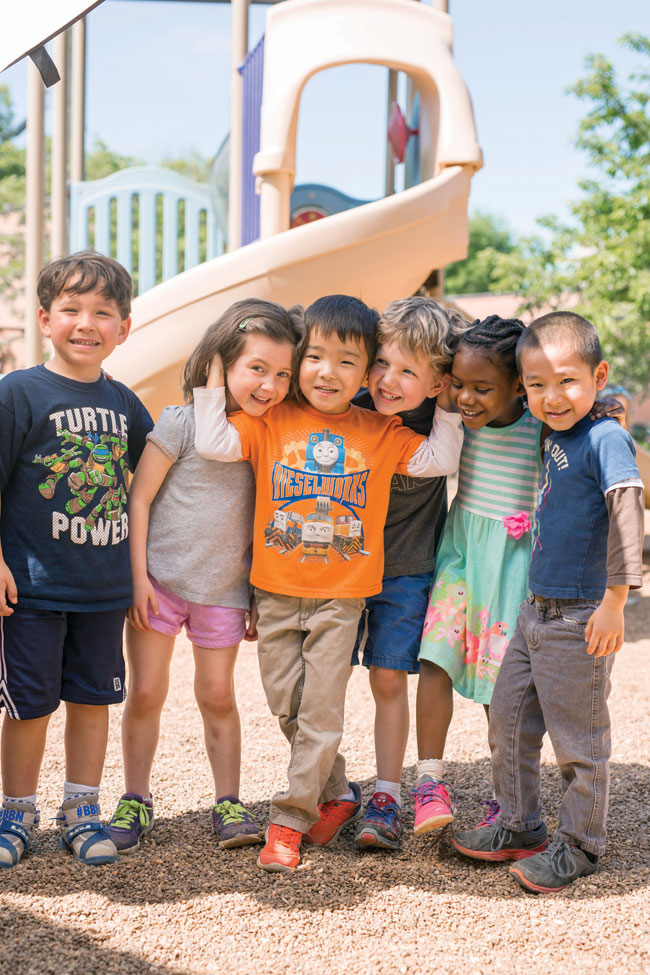
When Peabody professors Mark Lipsey and Dale Farran embarked on a study to evaluate the long-term benefits of Tennessee’s multimillion-dollar voluntary prekindergarten program, they fully expected conventional wisdom to prevail.
After all, pre-K is known to close the achievement gap between disadvantaged and advantaged kids. Pre-K prepares children for school, and that jump-start certainly must resonate throughout the early grades and beyond. Investing state funds into pre-K should be a no-brainer, right?
The first year’s round of data produced the expected glowing results: Children who attended pre-K were far more academically and socially prepared than those who stayed home. But fast-forward to the end of third grade, and that’s when things get complicated. The data paint a complex and not particularly rosy picture. The achievement for students who attended pre-K flatlined and actually dropped compared to those who did not attend.
The researchers, both longtime advocates for educational equality and pre-K education, trusted the data, making it that much harder to break the news last fall to the Tennessee Department of Education, which had partnered with them to conduct the study.
Pre-K in Tennessee
In 1996, Tennessee launched a statewide initiative to provide school-based prekindergarten to 4-year-olds whose parents’ incomes qualified them for free or reduced-priced lunch. As a commitment to the early childhood mission, state officials invested $85 million in the Tennessee Voluntary Pre-K Program (TN-VPK), ultimately expanding it to include 18,000 children in 935 classrooms across all 95 counties. In 2009, Lipsey and Farran partnered with the Tennessee Department of Education’s Department of Early Learning in a successful proposal to the U.S. Department of Education’s Institute of Education Sciences to evaluate the program.
Lipsey, a research professor of human and organizational development and director of the Peabody Research Institute, and Farran, the Antonio M. and Anita S. Gotto Professor of Teaching and Learning, were responsible for evaluating the program’s outcomes, both in readying children for school and long-term effects. The TN-VPK Effectiveness Study was a five-year, $6 million evaluation and the first randomized control trial of a state-funded pre-K program in the country.
“There is no doubt that quality pre-K sets the stage for achievement in kindergarten.”
—Mark Lipsey
Gathering data from a racially and ethnically diverse sample of 1,076 children whose parents consented, Lipsey and Farran began a study that would measure achievement levels of children in TN-VPK against a control group of children who primarily stayed home, meaning kindergarten was their first formal school experience. (Data from the state database on the full randomized sample of more than 3,000 children are currently being analyzed.)
The researchers found that children who had been in TN-VPK entered kindergarten with higher cognitive and social skills than their peers who had not attended a state funded pre-K.
“At the end of the pre-K year, the effects were statistically significant,” Lipsey said. “There is no doubt that quality pre-K sets the stage for achievement in kindergarten.”
By the end of kindergarten, both groups of children were scoring equivalently, and at or better than the national average. But the researchers were surprised to find that by the end of second and third grades the data lines began to cross. The control group—the children who had not attended pre-K—was actually outperforming the pre-K children on almost all measures of academic achievement, particularly in math.
“Compared to the national norm, both groups of children began to come down a bit and lose ground by the end of the third grade,” Farran said. “And children who had attended pre-K were losing ground a little faster. We had some ideas about what was causing these declines, but it was discouraging to see.”

Why the Declines?
The researchers began to consider what contributed to the story the data were telling. The first question they asked themselves was what TN-VPK should reasonably be expected to do for a child. If it is expected to prepare children for kindergarten, it does a terrific job, they believed. But if its role is to have a sustained lifelong academic benefit and overcome the ongoing pitfalls of poverty, the program was falling short.
“We expect pre-K to perform miracles, and that’s not fair to children or teachers or families,” Farran said. “It’s not fair to make promises to families living in poverty about what pre-K can do if we can’t keep them. Pre-K may build a foundation for disadvantaged children. But it’s not a panacea, and it doesn’t counteract the many challenges families living in poverty face.”
“[Pre-K] is not a panacea, and it doesn’t counteract the many challenges families living in poverty face.”
—Dale Farran
Another issue the researchers examined was the consistency in curriculum and pedagogy across Tennessee’s pre-K classrooms—or lack thereof.
“There is no standard that all the classrooms are held to, so the quality varies widely,” Lipsey said. “What and how the students are taught in one classroom can be very different from what is happening in another classroom. It wouldn’t be right to say simply that we need pre-K in Tennessee. We need quality, scaled-up pre-K—and there is a big difference there.”
The quality of the instruction in grades 1-3 also was part of the discussion. “We should consider what happens when these children, who have grown up in low-income neighborhoods, advance to the early grades,” Lipsey said. “They are not likely to attend the best schools or be taught by the best teachers. Sustaining the momentum these children have coming out of pre-K can be difficult under these circumstances.”
Overcoming the Power of Poverty
Quality pre-K can provide a jump-start for students from poor families, but it can’t overcome the myriad issues they face when they get home, such as food insecurity, neighborhood crime and lack of access to books and other enrichments necessary to provide a scaffold for their learning. Pre-K, the researchers say, is only part of the solution.
“Quality pre-K works and is necessary for starting children on the path to learning,” Farran said. “But we need to find ways to make pre-K a more viable component of early childhood education. We need to look at all the other factors in these children’s lives, and take a multipronged approach to providing the best opportunities across the 0–5 years that will have long-lasting effects.”
Rather than seeing pre-K as simply preparation for school, it might better serve disadvantaged children—or all children, for that matter—to treat it as an integral part of the education and development continuum and infuse it with experiences that would cultivate that development, Farran said.
“A child’s early development is so important, but it can’t be viewed as disconnected from kindergarten, first grade and beyond. The experiences are connected, and every step builds on the last. It’s important that we see a child’s education as a journey that needs to be supported by all aspects of society if we are to prepare the future leaders of the world,” she said.
Keeping the Conversation Going
When it was time to roll out their latest round of data last fall, Lipsey and Farran arranged private meetings with important thought leaders and stakeholders, including the Tennessee education commissioner, the staff of Gov. Bill Haslam and the chairs of the Tennessee Senate and House education committees. They outlined the results, as well as what they believed needed to happen for Tennessee to best use the data.
“The commissioner of education interpreted this as a challenge to improve quality and to better align with later grades,” Lipsey said, “and there began to be some sentiment in the Legislature to support that. One of the more important consequences of all this is that we stimulated an important conversation about what was expected from the state pre-K program.”
“… we are gratified that our results have provoked productive discussions that will lead to a greater understanding of the power of pre-K and how to best serve our most vulnerable students.”
—Dale Farran
The meetings were only the beginning of a nationwide conversation on the state of pre-K in Tennessee. A host of news outlets—from The Huffington Post to Education Week to The New York Times—were eager to use the comprehensive study as a measuring stick for other states and the nation.
As expected, Tennessee lawmakers quoted the data in legislative chambers, some to decry the value of pre-K, others to support reform, still others to provoke thoughtful consideration of not only pre-K education but related issues like food insecurity, affordable housing and teacher wages.
“The conversation continues, and we are gratified that our results have provoked productive discussions that will lead to a greater understanding of the power of pre-K and how to best serve our most vulnerable students,” Farran said.
Farran is involved in an ongoing intensive partnership with Metro Nashville Public Schools to analyze its pre-K operation, including evaluating three experimental early-learning centers to determine what’s working and not working for the children. She is also leading an evaluation of the effectiveness of the new federal funds to expand pre-K in MNPS and Shelby County.
“We are trying to help them develop a vision that’s more empirically based on how to make pre-K work better,” Farran said. “If you’re going to have pre-K in the public schools, what are the best things you can do to make it better?”
In March 2016, lawmakers crafted the Tennessee Pre-Kindergarten Quality Act that requires changes in current practice in the Tennessee program that are aimed at improving its quality. The legislation passed in both the House and Senate, and was signed into law during the spring session.